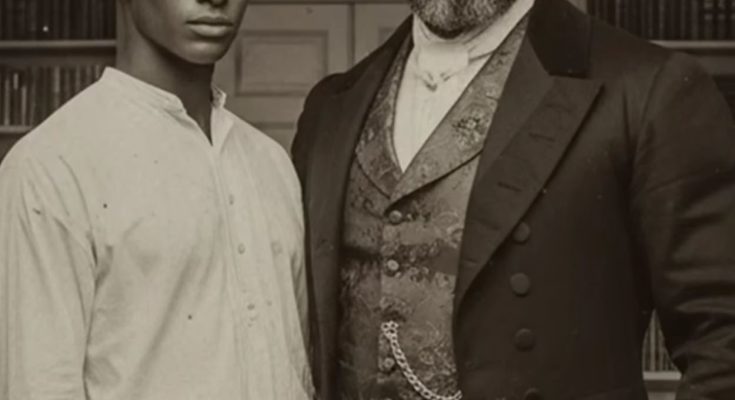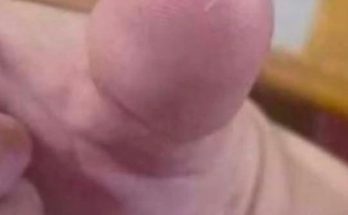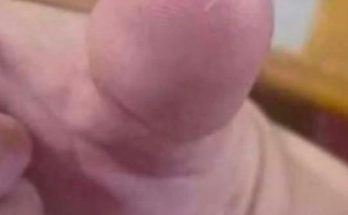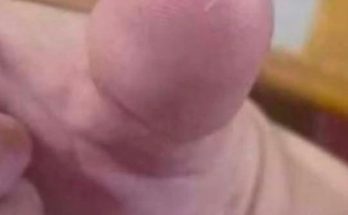The Forbidden Experiment of Blackwood Manor: The Scandal That Savannah Tried to Erase
On a humid August morning in 1858, the servants of Blackwood Manor gathered in uneasy silence outside the grand bedroom of their master, Colonel Harrison Blackwood.
Inside, the 48-year-old plantation owner — one of Savannah’s most powerful men — lay dead in his bed, his face frozen in an expression doctors would later describe as “agony intertwined with ecstasy.”
But that wasn’t the scandal.
What stunned Savannah society was who they found lying beside him: Morgan, a 23-year-old enslaved person whose body, according to physicians, defied every law of anatomy known at the time.
Within days, whispers turned to outrage. Reports leaked that Morgan possessed both male and female sexual organs — “fully formed and functional,” according to the attending physician’s notes. Even in a city accustomed to scandal among its elite, this was something else entirely.
By week’s end, Blackwood Manor was surrounded by rumors darker than the Spanish moss hanging from its trees — tales of medical experiments, unnatural unions, and a pregnancy that should have been impossible.

Within a year, thirteen people connected to the Blackwood estate were dead, the mansion itself burned to the ground, and the family name erased from Savannah’s public record.
What really happened behind those white columns? And who was Morgan — a slave, a lover, or something that terrified a society built on the illusion of control?
The Purchase That Changed Everything
The story begins eight years earlier, on a stifling September afternoon in 1850 at the Charleston slave market.
Colonel Harrison Blackwood, a man with 3,000 acres of cotton and an impeccable Virginia lineage, had come to buy field hands. He was not looking for trouble — just labor. But when the auctioneer presented “Lot 47,” the colonel’s steady composure cracked.
The young person standing on the block was unlike anyone he’d ever seen. Labeled simply Morgan, age 15, origin unknown, the youth’s features blurred every social and physical line of the era — soft-skinned, lithe, and beautiful in a way that left spectators uneasy.
The auctioneer’s voice faltered as he read the note attached to the file: “Unique physical characteristics. Documentation available upon request. Buyer assumes all complications.”
When no one else bid, Blackwood raised his hand.
Two hundred dollars. Sold.
Later, in a private office, the clerk handed over a sealed envelope marked Medical Disclosure. Inside, a physician’s examination revealed the truth: Morgan was intersex — “hermaphroditic,” the document read, with both male and female reproductive anatomy.
Previous owners had sold the slave quickly, describing “moral discomfort” and “social disruption among the quarters.”
Blackwood should have walked away. But the man who prided himself on reason and restraint felt something stir — curiosity first, fascination second, and something darker that he dared not name.
“I have purchased not labor,” he wrote in his diary that night, “but a living contradiction — an embodiment of every question I have never dared to ask.”
A Dangerous Connection
Blackwood brought Morgan to Savannah as a house servant — an unusual position for someone of ambiguous status. His wife, Constance Fairfax Blackwood, noticed immediately.
At 32, Constance was the model of southern decorum: pale, proud, and brittle with suppressed rage. Her husband’s frequent absences and her failure to produce a male heir had hardened her into a woman who spoke in perfectly measured sentences that cut like glass.
“This one seems delicate,” she remarked coolly when introduced to Morgan. “Might be better suited for work far from the main house.”
But Harrison ignored her. He placed Morgan in a small room adjoining his study — a space meant for clerks or secretaries — and explained, “You will manage my correspondence. You may read any book you wish from my shelves. But this remains between us.”
For Morgan, literacy was a dangerous gift. For Harrison, it became the beginning of obsession.
Night after night, as the plantation slept, he returned to the study where Morgan waited by lamplight, reading aloud from Milton, Plato, or Sappho.
Conversations about philosophy turned into confessions about loneliness. The colonel — a man who owned over 200 enslaved people — found himself disarmed by a person he could neither categorize nor fully possess.
“How do you think of yourself?” he asked one night.
Morgan’s answer would haunt him:
“I think of myself as Morgan, sir. The world needs me to be one thing or another, but God made me both. And I’ve learned that makes people afraid.”
The Night the Line Was Crossed
In January 1851, during one of their late-night discussions, Harrison reached for a book and their hands touched.
That small, electric moment — the contact between master and slave — marked the beginning of something that would destroy them both.
Over the next seven years, their secret deepened. What began as intellectual kinship evolved into passion — raw, impossible, and utterly forbidden.
Harrison’s journals, recovered after his death, reveal a man torn between societal duty and private revelation. “Morgan is neither man nor woman,” he wrote in 1854.
“But perhaps that is the truest reflection of creation itself — a harmony of opposites that the world calls abomination, but I call perfection.”
In public, Colonel Blackwood remained the picture of refinement. In private, he built a secret world with Morgan — a place where gender, race, and hierarchy briefly ceased to exist.
But someone was watching.
The Wives and Witnesses
Constance Blackwood noticed the changes first — her husband’s sudden kindness, his long hours in the study, the way his eyes followed a particular servant.
For a while, she dismissed it as boredom or vanity. Then, one night in 1857, she awoke to strange sounds from below: gasps, whispered names, the creak of furniture.
She approached the study door and looked through the narrow opening.
What she saw — her husband entwined with someone society called property — turned her blood cold. “It was not only betrayal,” she later wrote in an unsent letter, “it was blasphemy.”
But Constance was not a woman to act impulsively. She said nothing for nearly a year, choosing instead to watch, to gather evidence, and to wait.
She wasn’t alone.
Margaret Chen, Constance’s mixed-race ladies’ maid — half African, half Chinese — had also been observing. Educated, quiet, and underestimated, Margaret had long ago learned that information was power.
She found the combination to the locked cabinet in Harrison’s study and began reading his private journals in secret.
What she found inside those pages would change everything.
“These were not confessions of sin,” she wrote in a later affidavit. “They were love letters — to a person the world said could not exist.”
Margaret understood what was coming. When the scandal exploded, the system would destroy Morgan first. And so she made a plan of her own.
The Impossible Child
In the spring of 1858, Morgan began to feel ill.
By July, the changes were undeniable. Dr. Benjamin Marsh, the family physician, examined the enslaved attendant and left the room visibly shaken.
“Colonel,” he whispered, “this person is with child.”
“Impossible,” Harrison replied.
But it wasn’t.
Whether through a genetic anomaly or a miracle of nature, Morgan was four months pregnant. For a society that prided itself on order, hierarchy, and divine design, the news was unthinkable — a hybrid child born of a master and a person whose very existence challenged the concept of gender.
Dr. Marsh urged immediate termination. Constance, who overheard the conversation through the study door, wanted something else: revenge.
By morning, she had made her decision.
Poison in the Parlor
That night, Constance prepared a plate of food and delivered it personally to Morgan’s quarters. Margaret followed her mistress quietly, watching from the shadows.
Moments later, when Constance left, Margaret entered the room and switched the plate for one she had prepared without poison.
When Constance returned and saw Morgan still alive, the deception enraged her. A struggle broke out. Margaret struck her mistress with a heavy candlestick, rendering her unconscious.
Fearing retribution, Morgan and Margaret fled into the night with a bag of gold coins, forged freedom papers, and the route north that Margaret had memorized from whispers about the Underground Railroad.
By dawn, they were gone.
And by noon, Harrison Blackwood — having discovered his wife’s actions and the empty bed — made a fateful choice.
The Final Act
When servants entered the study the next morning, they found Harrison in Morgan’s room, wearing Morgan’s clothes, surrounded by eight years of journals. He had consumed a lethal dose of laudanum mixed with arsenic.
On the wall, written in his own blood, were his last words:
“I die loving Morgan. My only sin was not doing so openly.”
To protect his lover, Harrison staged his own death as suicide, ensuring Constance could never accuse Morgan of murder.
But Savannah wasn’t finished with the Blackwoods. Within days, rumors of “unnatural acts” and “Godless unions” spread like wildfire. The coroner sealed the journals. The church refused burial rites. And Constance, humiliated and furious, left Georgia with her daughters, never to return.
The Letter from Boston
Three months later, a letter arrived at the Savannah police station — postmarked from Boston, written in careful, educated script.
It was from Morgan.
The letter detailed everything: Constance’s attempt at poisoning, Margaret’s intervention, the violent struggle, and their escape north. It revealed that Harrison had not taken his life in despair but had sacrificed himself to save theirs.
“He gave his life for mine,” Morgan wrote. “Not out of guilt, but out of love. The world will call him a monster. I will remember him as the only man who ever saw me as human.”
Morgan confirmed the pregnancy had come to term. The child — healthy, unnamed, and described as “beautiful beyond description” — was being raised in Boston by abolitionist allies.
The letter closed with one line that Savannah’s officials read in silence:
“We are neither his sin nor your scandal. We are his truth.”
Legacy of the Forbidden
The Blackwood scandal became one of the most covered-up stories in Southern history. But fragments survived — in police reports, court archives, and abolitionist pamphlets published in the North.
Frederick Douglass cited Harrison’s journals in an 1860 speech as proof that slavery “corrupted every human bond it touched.”
Harriet Beecher Stowe, according to later correspondence, read excerpts before writing The Minister’s Wooing, which explored moral hypocrisy in the South.
In 1885, a Boston publisher released a memoir titled Neither Nor: A Life Beyond Categories by an anonymous author widely believed to be Morgan. The book described life as an intersex enslaved person, the years at Blackwood Manor, and the night of escape.
It ended with a letter addressed to Harrison:
“You asked what I was. I am what your world feared most — a being who cannot be owned, defined, or erased. You loved me before I loved myself. For that, I forgive you everything.”
Morgan lived openly in Boston until 1902, dying at 67. The child they bore became a physician specializing in “atypical anatomies,” publishing quietly under another name.
As for Constance, she died alone in Virginia, having never remarried. Among her possessions was one of Harrison’s journals — the first volume, filled with love notes written in his hand and margin notes written in hers.
The early pages were bitter. The later ones, simply underlined.
What Savannah Forgot
Blackwood Manor no longer exists. The land, once a monument to power, is now a stretch of overgrown marsh and pine. But dig deep enough into Savannah’s historical archives and the story still breathes — not as a ghost tale, but as a warning.
Harrison and Morgan’s love defied every rule of their time: master and slave, white and Black, male and female. It was doomed, yes — but it also illuminated a truth that remains timeless: the human heart refuses to obey the boundaries society builds around it.
The tragedy of Blackwood Manor isn’t just about forbidden love or scandal. It’s about what happens when a society demands purity, conformity, and silence — and what it costs to break that silence.
In a world that buried their names, Morgan and Harrison built something indestructible: a record of two people who dared to see each other completely.
The Final Word
Today, historians debate whether the Blackwood journals are authentic, whether Morgan’s memoir was fact or allegory. But even if the details blur in the fog of time, the question remains clear:
How far would you go to love honestly in a world that insists you cannot?
Because sometimes, the most dangerous experiments aren’t done in laboratories — they happen in the human heart.



